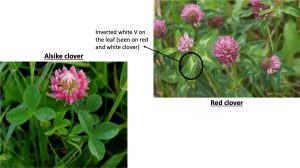With spring finally approaching and horses being turned out to pasture again, we wanted to raise awareness on a couple of plants that are commonly found in pastures (and hay) that can cause issues in the horse.
Please join us over the next few weeks while we go over some of the most common plant toxicities as well as what the signs are and how to recognize the plants.
Alsike clover poisoning
 Alsike clover is a type of clover commonly found in pastures in Northern Canada. Even though it looks a lot like red clover (which in and of itself is not harmful), there are some notable differences that might help you determine whether or not you have alsike clover in your pasture. The most notable difference is the typical white V on the leaves of red and white clover, which you will not find on alsike clover. Alsike clover also grows a lot higher than red or white clover does (15-30” compared to 10-15”) . While white clover has a white flower while it is in bloom, both red and alsike clover can be recognized by the typical pink-purple flower at the top.
Alsike clover is a type of clover commonly found in pastures in Northern Canada. Even though it looks a lot like red clover (which in and of itself is not harmful), there are some notable differences that might help you determine whether or not you have alsike clover in your pasture. The most notable difference is the typical white V on the leaves of red and white clover, which you will not find on alsike clover. Alsike clover also grows a lot higher than red or white clover does (15-30” compared to 10-15”) . While white clover has a white flower while it is in bloom, both red and alsike clover can be recognized by the typical pink-purple flower at the top.
Now, what happens when a horse ingests alsike clover. While the mechanism by which alsike clover causes issues is not completely known yet, we do know that it can cause 2 syndromes: photosensitization and big liver syndrome.
Photosensitization can occur even with short-term ingestion. Typically this is visible as reddening and flaking or crusting of the skin after UV-exposure. These lesions can be very painful and if they occur on the muzzle, it can actually cause the horse to stop eating and drinking properly. These lesions are usually seen only on the white (unpigmented), or light-colored areas of the horse.
Big liver syndrome on the other hand is seen with long-term ingestion of alsike clover. The long term consumption leads to a build-up of toxins in the liver, which in turn leads to destruction of the functional tissue in the liver (causing liver failure). Symptoms for this are usually more vague, but signs to look out for include jaundice, lethargy and colic signs. A blood test is the best way to diagnose if your horse is experiencing liver issues.
Treatment for these syndromes will vary based on the severity of the clinical signs as well as blood work, but does usually involve IV fluids in order to help flush the liver. Besides that, topical treatment for the skin lesions caused by photosensitization and adjustment of the diet for the liver disease are usually part of the treatment plan.
While consumption of the plant should be avoided, we do notice that consumption is small amounts (< 5% of the diet) does not seem to cause noticeable issues. Most horses will not really eat clover (as it tastes quite bitter), as long as there is plenty of good quality forage available to them and they do not need to compete for food. However, when alsike clover is dried and present in the hay, the taste does not seem to bother them as much, and horses tend to be more likely to eat it. So make sure to check your hay as well.
If you do notice you have alsike clover present in your pasture, the best way to get rid of it is to treat the pasture with a broad-leaf herbicide. This is best done when the plant is in its growth fase or actively blooming.